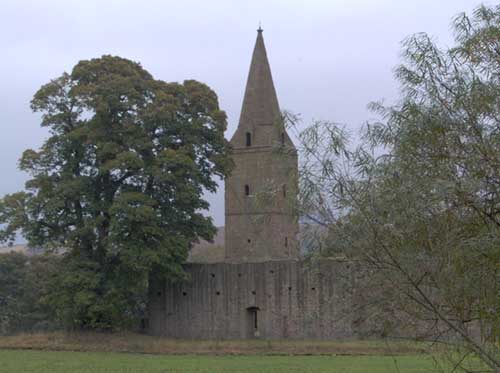
The ancient priory church at Restenneth, by Forfar, is believed to have been founded by Nechtan, king of the Picts about 715. He sent to the Abbot of Wearmouth, near Corbridge, to ask for instruction in the Christian faith, and also for builders who could build in the Roman style, that is in stone, a new innovation or the period. In return Nechtan promised to dedicate the church to St Peter. Recent opinion favours a late 11th century date for the base of the tower. In either case, the church is one of the very earliest stone buildings in Scotland.
Little is known about the first 400 years of the church's history until the reign of King David I. He granted a charter giving Restenneth various thanages and other royal lands. By 1162 Restenneth comes more into focus when the church is given by King Malcolm IV (1153-1165) to the Abbey of Jedburgh and it comes under the rule of the Augustinian canons. The king granted Restenneth to Jedburgh Abbey for the welfare of the soul of his grandfather David I, his parents Prince Henry and Ada, and the souls of his sisters and all of his other antecessors and successors. The priory also served as the parish church for the parish of Forfar.
Malcolm IV's charter confirmed extensive land holdings and privileges including the lands of Craignathro, Pitreuchie, Tealing, Dunninald, Dysart and Egglispether with their benefits, teinds of the kings holdings in Angus which included money, wool, chickens, cheese, malt and those teinds of the mill and fish market of Forfar, the whole teinds of the king's farms or lordships of Salorch [Montrose], Montrose [Old Montrose], and Rossie, free passage on the Firth of Forth, a toft in each of the burghs of Perth, Stirling, Edinburgh, Montrose and Forfar and 20s for the light of the church in Salorch [Montrose], and the king's salt pits and mill of Montrose. The Priory was well endowed with material possessions.
Restenneth Priory
The area was popular with many of the early Scottish kings. Malcolm Canmore and Queen Margaret favoured Forfar with both its castle and royal palace. It was also favoured by William the Lion, Alexander II and Alexander III. They spent a time in Forfar hunting in the surrounding countryside. The palace or castle must have had a large garden as a royal gardener was employed, earning 5 merks a year.
Life for the 8 or so canons who resided at Restenneth went on peaceably until the Wars of Independence. They continued to build and improve the church buildings. On August 1243 the church at Restenneth consecrated by David de Bernham, bishop of St Andrews, probably marking the completion of the chancel. Such building work was soon to be undone. Robert the Bruce and the English King Edward I fought over this part of Scotland. Each destroyed castles and other strategic buildings that they could not hold. Robert the Bruce destroyed the castle at Forfar, never to be rebuilt or be a royal residence again. During the Wars the church at Restenneth was burned with the loss of its muniments, some national records and those of its motherhouse at Jedburgh. They were "lost and carried off by wars, and other accidental causes". Later, in 1321, an inquest was carried out to determine and restore the Priory's rights and privileges. Edward I did allow the canons to make some repairs and granted them 20 oaks from the forest of Plater (Finavon).
No Comments Yet - Why not be the first to leave a comment
Every effort is made to make sure that all the information is correct but we strongly recommend that you call Restenneth Priory before you set off on your day out to confirm opening times and admission prices.
Please also note that the position on Google maps for Restenneth Priory is a rough estimate using their postcode in the database and might be slightly out.
It may also be worth clicking the web link for Restenneth Priory to see if there are any special events coming up or currently on.